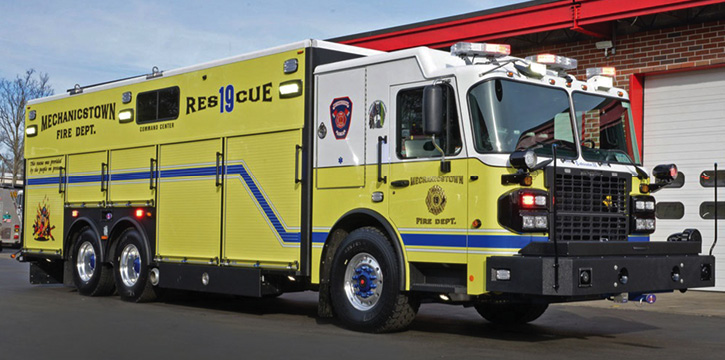
The Mechanicstown (NY) Fire Department is located in the Orange County area of New York and, like most of the fire departments in this area, it operates in a suburban setting.
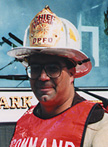
The all-volunteer department covers 17 square miles that have a population of 8,000. It has Routes 17 and 84 running through its district as well as a large shopping mall, numerous strip shopping centers, condos, schools, and an area that has large warehousing. It also has a nonhydranted area with dairy farms and residences. The department itself is located just southeast of Middletown and is a proactive and progressive fire department when it comes to designing and purchasing fire apparatus.
REPLACING A RIG
According to Commissioner Jay McClintock, “Our board of fire commissioners usually replaces our frontline apparatus on a 20-year basis for engines and other vehicles; our heavy rescue in 25 years. Our 1994 Saulsbury rescue was right at that time frame, so we began to formalize a plan to replace it a little over a year ago.”
Related Content
- Apparatus Ideas: Patchogue FD Union Hook and Ladder Co.1
- Apparatus Ideas: Technical Rescue Rig Helps Department Expand Capabilities
- Apparatus Ideas Archive
McClintock says that the department wanted to make several changes for its new rescue truck and wanted it to be equipped to serve the community well into the future without running out of room for equipment. “Our past rescue had served us well,” says McClintock, “but we really needed to increase our compartment space. The need to carry more specialized equipment drove the design of this new unit.”
Mechanicstown checked out various manufacturers to build the new unit and decided to go with a Spartan ER cab and chassis, having operated several of these chassis in the past and being happy with their operation. The local dealer is Hendrickson Fire Equipment and Alan Rich, who steered the department toward Rescue 1 to look at its rescue bodies. “Looking at various units under construction at their plant in Manasquan, New Jersey, which by the way was only a two-hour drive for us, sold us on choosing them,” says McClintock. “Their attention to detail, as well as their tool mounting options, really impressed us a great deal.”

1 The Mechanicstown (NY) Fire Department heavy rescue with a Spartan Gladiator cab and chassis and Rescue 1 body. (Photos courtesy of Rescue 1.)
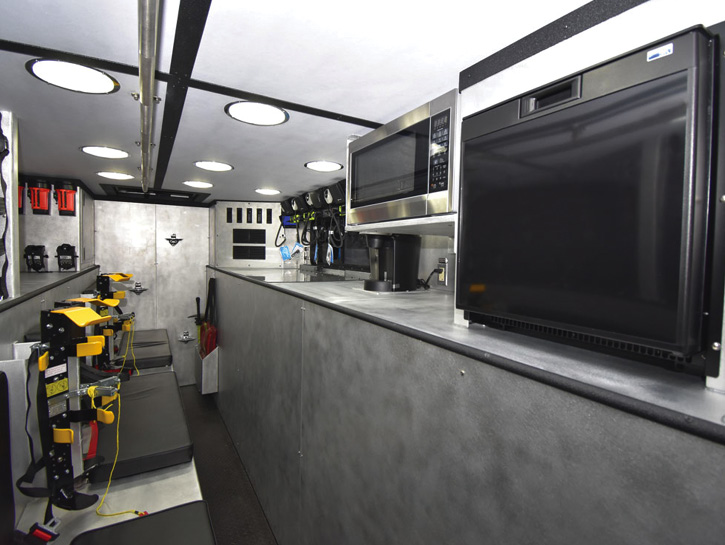
2 The interior command post with command board and radios.
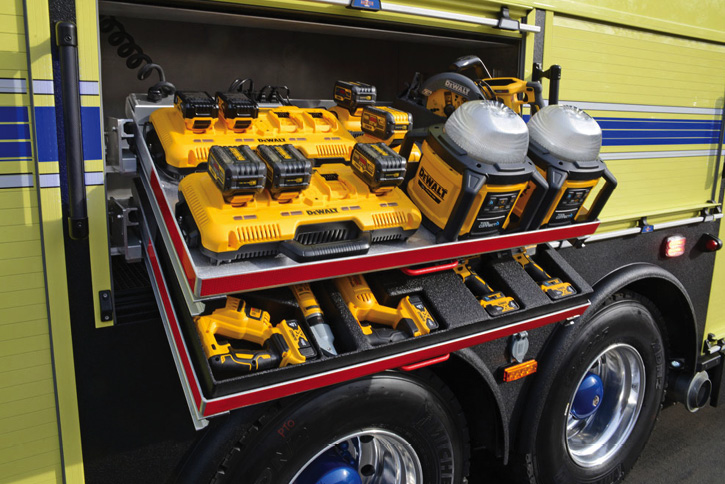
3 A compartment dedicated to DeWalt battery-powered tools with extra batteries on charge.
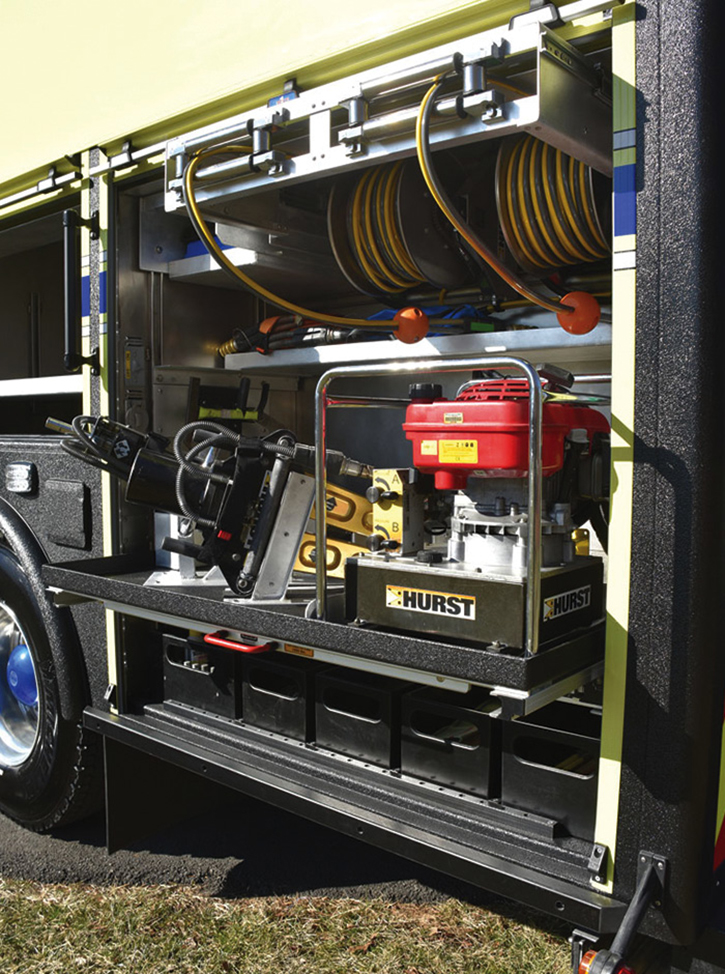
4 One of three HURST tool compartment with hydraulic reels.

5 The right-side saw compartment.
For this build, the department decided to go from a single rear axle to a dual rear axle to handle the additional equipment it expected to carry as well as braking capability. “While most fire departments these days are going from a walk-in type rescue box to a walk-around arrangement, we decided to go with a walk-in box,” McClintock says. “The reason is that we wanted to set up a command post inside the box that would have a small command board and a series of radios as well as an area where our firefighters could get suited up if we had to respond to an ice or water rescue. It could also be used for a rehab area if needed. The truck also has a roll-out awning on the side of the box for shade, and in the rear of the box is a small refrigerator, coffee pot, and microwave for this concern.”
| Rescue 1 Heavy Rescue Spartan Gladiator cab and chassis 10-inch raised-roof cab 22,800-pound Meritor front axle 40,000-pound Meritor rear axle Cummins X15 505-hp engine Allison EVS 4000 transmission Engine brake Advanced Protection System Onspot tire chains Rescue 1 stainless steel 26-foot rescue box 28-inch extended front bumper Robinson roll-up doors Four 100-foot hydraulic reels Two 150-foot air hose reels Two 250-pound tip-down roll-out trays 1,000-pound roll-out tray 500-pound roll-out tray Four winch receiver points Will-Burt light tower with six Pioneer LED lights and Oculus camera system with DVR and remote control Electric air compressor Onan PTO-driven 35-kW generator Mobile modem/router for WiFi hot spot Whelen LED light package |
VEHICLE SPECS AND EQUIPMENT
The vehicle has a 26-foot rescue box, which is an increase from the 17-foot box on its older unit. It has a built-in air compressor with two 100-foot air reels, a 35-kW generator (up from a 20-kW), two 200-foot electrical reels, and a Will-Burt light tower with a video camera mounted on the mast that will record to a DVR box. There is also a 28-inch extended front bumper that contains a complete set of HURST Jaws of Life eDRAULIC spreaders, cutters, and rams. “Because of the longer box and chassis, we have a great deal more compartment space to carry truck company tools, saws, forcible entry tools, Paratech struts, air bags, cribbing, and a compartment just for hand tools,” says McClintock. “Even though we have the eDRAULIC system on the front bumper, we have four 100-foot hydraulic hose reels located on either side of the box to operate the standard HURST tool setups. We were also able to add a Stokes basket, Little Giant ladder, and an 18-foot roof ladder and 10-foot attic ladder.”
Because Mechanicstown has Routes 17 and 84 running through its response area, the department responds to many MVAs and auto extrication runs, so having the vehicle equipped with tools to handle these incidents was a must. “Also installed were numerous heavy duty roll-out trays for easy access to the tools for our firefighters at an emergency scene,” adds McClintock.
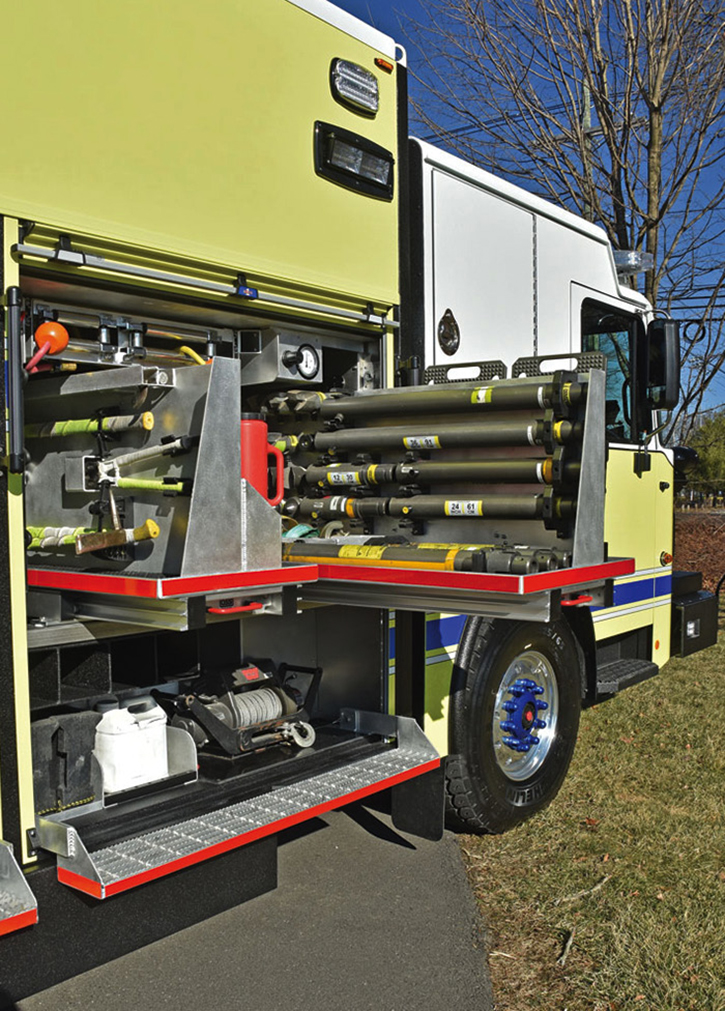
6 Paratech struts, a portable winch, and air and electric lines.
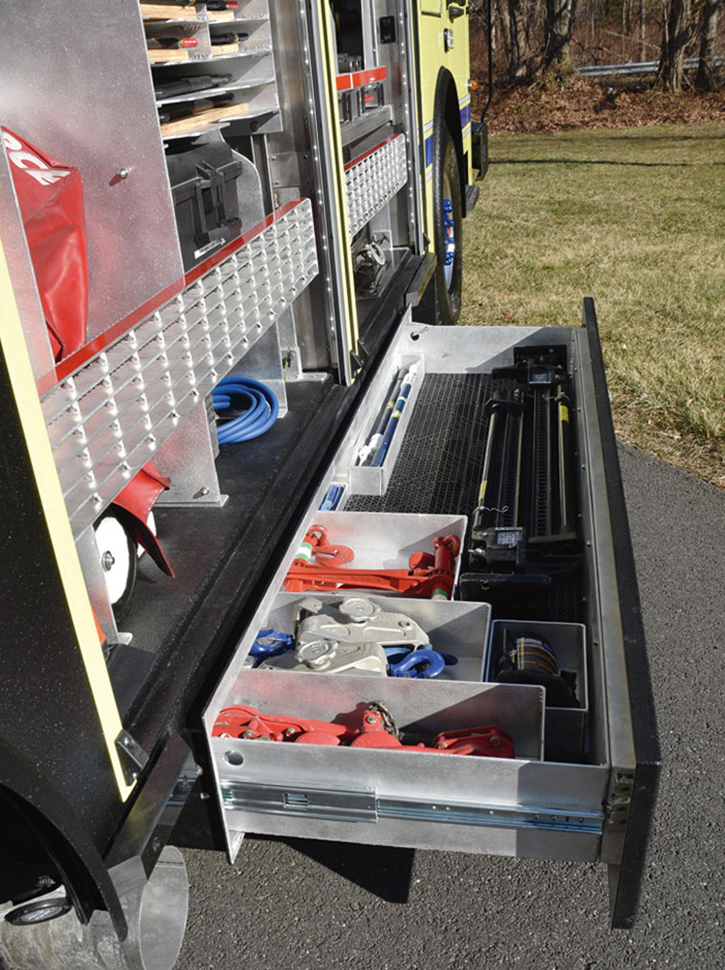
7 A roll-out under-body compartment with rigging equipment.
The chassis was also undercoated for the harsh winters Mechanicstown experiences to prevent rust on the underside of the chassis, and all compartments and interior of the cab were coated with Line-X to prevent added wear and tear. McClintock adds that the department went with a stainless steel body as well. “I’d like to think we covered every conceivable area in designing this new unit,” he says. “Our salesman Alan Rich and Hendrickson as a dealer were great to work with. They listened to all of our ideas and concerns and helped us along the way. Dealing with the staff at Rescue 1 was also a great experience. We brought our old rescue truck down to the factory, and they swapped and mounted all of our old and new equipment. They utilized and optimized every square inch of the vehicle with no wasted space.”
The Mechanicstown Fire Department planned well for this new purchase. It made numerous improvements to the new vehicle with added compartment space, configuration of tools in the compartments, as well as carrying additional equipment that meets the needs of its response district. It worked well with its local dealer and body manufacturer to get what it wanted with added space for the future. Also considered was the ease of operation for its firefighters. All these items should be on your to-do list when you begin the process of designing a new apparatus for your department.
BOB VACCARO has more than 40 years of fire service experience. He is a former chief of the Deer Park (NY) Fire Department. Vaccaro has also worked for the Insurance Services Office, the New York Fire Patrol, and several major commercial insurance companies as a senior loss-control consultant. He is a life member of the IAFC.

